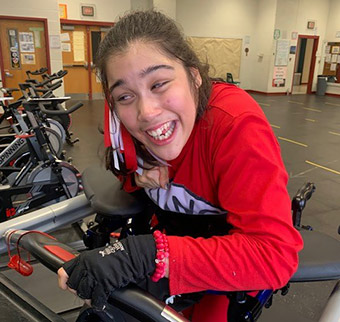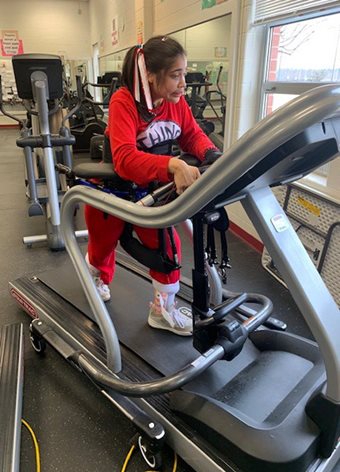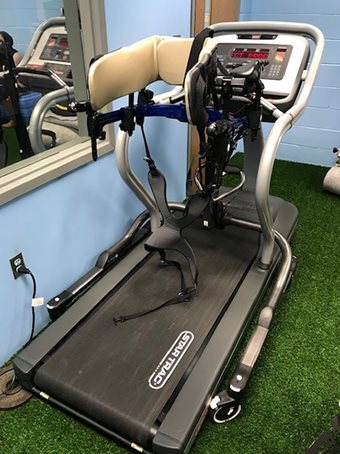 As a pediatric physical therapist working in public schools, I want my students to move, and to move in the same way their peers do. When Rifton came out with the treadmill gait trainer, I was eager to explore increasing exercise intensity for my teenagers with mobility impairments. I was fortunate enough to get funding for one in my school. I went to the literature to look for protocols using gait treadmills for youth with disabilities and did not find much. I chose to use FITTE (frequency, intensity, time, type, enjoyment) as guidance parameters. These parameters are well described in this useful Academy of Pediatric Physical Therapy fact sheet. The adapted physical education teacher and I collaborated on how to program, and decided to have the student walk to tolerance and then discontinue treadmill training when gait deteriorated.
As a pediatric physical therapist working in public schools, I want my students to move, and to move in the same way their peers do. When Rifton came out with the treadmill gait trainer, I was eager to explore increasing exercise intensity for my teenagers with mobility impairments. I was fortunate enough to get funding for one in my school. I went to the literature to look for protocols using gait treadmills for youth with disabilities and did not find much. I chose to use FITTE (frequency, intensity, time, type, enjoyment) as guidance parameters. These parameters are well described in this useful Academy of Pediatric Physical Therapy fact sheet. The adapted physical education teacher and I collaborated on how to program, and decided to have the student walk to tolerance and then discontinue treadmill training when gait deteriorated.
Initial Success
My first experience was with a young woman who is GMFCS Level III. She used the gait trainer over the treadmill in school, 2-3 times per week, increasing her tolerance to 15-minute sessions over the course of a Spring. The school staff quickly became adept at having her use the treadmill set-up, and I checked in on her 3-4 times per month. At the same time, she used a Rifton gait trainer over-ground with trunk, hip and arm positioners and staff noted she seemed to walk faster in it as a result of the treadmill practice. Cursory data confirmed this.
Improvements in Walking Speed and Duration
Fast forward to the next school year. Rachel, a 15 year old young woman with cerebral palsy seemed a perfect candidate for treadmill gait training. She is GMFCS Level IV, a happy-go-lucky independent wheelchair driver with excellent spatial skills and one of the hardest working students on my caseload. She walks in her gait trainer during physical education (PE) and within her school routine to access the bathroom – a total of around 300 feet daily.

We decided to trial her on the treadmill gait trainer during PE for the fall semester. Along with the treadmill gait training 2-3 times per week, Rachel did exercises on a mat, hand ergometer-based strengthening and participated in games that included dance and ball activities. Equally important was providing over-ground walking opportunities in her gait trainer alongside her treadmill gait trainer routine. She rapidly increased her walking tolerance to 15 minutes (see Table 1). She also increased her walking speed, as indicated by her time to walk two “laps” (see Table 2).
More important to Rachel than walking distance or walking speed is her level of enjoyment in the activity. Consider this in the context of the “F-Words” of childhood disability: Function, Family, Fitness, Fun, Friends and Future. Rachel loves walking on the gait trainer, and listening to Taylor Swift helps her work even harder. When she gets off she is sweaty… and happy. I think about the benefits of exercise-induced endorphins, the weight-bearing she is getting through her long bones and joints. And I think about how this can improve her future health and function.
Table 1: Treadmill gait trainer walking time at 0% incline.
One lap equals 0.1 miles
|
Date |
Speed |
Time tolerated |
|
9/18/2018 |
.5 mph |
10 |
|
9/20/2018 |
.7 |
10 |
|
9/24/2018 |
.7 |
10 |
|
10/9/2018 |
.8 |
12 |
|
10/15/2018 |
.8 |
15 |
|
10/23/2018 |
.9 |
15 |
|
1/8/2019 |
.7 |
20 |
Table 2: Time to Walk 0.2 miles in gait trainer
|
Date |
Time (seconds) |
|
9/26/2018 |
10:28 |
|
10/4/2018 |
7:59 |
|
10/11/2018 |
9:47 |
|
10/17/2018 |
7:24 |
|
11/2/2018 |
8:40 |
Unfortunately, this preliminary data is not stringent enough for a peer-reviewed case study, but I am sharing it with you because, until we have evidence-based protocols, all we have to go on is Level V evidence and our clinical judgment and observations. And from our observations, it seems that treadmill walking allowed the students to rapidly increase their tolerance and ability to walk. However as Rachel’s APE teacher noted, treadmill walking is not the same as over-ground walking. A real life environment involves distractions, the need to turn corners and negotiate obstacles. So this is another consideration as well.
What is next?
 Our IEP team believes that this physical activity contributes to the fitness of our students which will contribute to long term health. We appreciate the enjoyment that students have when they exercise and listen to their favorite music. We want this activity present in our school, but we also want to show a physical benefit. We now have our students walk for blocks of 4-6 weeks on the treadmill, and then 4-6 weeks of overground walking. We are measuring cardiovascular response to walking in both situations, using a pulse oximeter at rest and during training. Our outcomes measure is the time it takes to cover a designated distance (0.2 miles).
Our IEP team believes that this physical activity contributes to the fitness of our students which will contribute to long term health. We appreciate the enjoyment that students have when they exercise and listen to their favorite music. We want this activity present in our school, but we also want to show a physical benefit. We now have our students walk for blocks of 4-6 weeks on the treadmill, and then 4-6 weeks of overground walking. We are measuring cardiovascular response to walking in both situations, using a pulse oximeter at rest and during training. Our outcomes measure is the time it takes to cover a designated distance (0.2 miles).
Detailed protocols on treadmill gait training parameters are desperately needed. Booth and colleagues (2018) published a systematic review on gait training in the pediatric population and that was a start, but specific recommendations are still scarce. We also need to know what to measure: perhaps we should also be measuring enjoyment in addition to other physiological parameters. But in the meantime, we need clinicians to use clear outcomes measures, document the parameters and share them with others. I would like to see more youth engaging in physical activity that includes gait trainers and treadmill gait trainers using standardized protocols to maximize their benefit.
References:
Booth, A. T., Buizer, A. I., Meyns, P. , Oude Lansink, I. L., Steenbrink, F. and Krogt, M. M. (2018), The efficacy of functional gait training in children and young adults with cerebral palsy: a systematic review and meta‐analysis. Dev Med Child Neurol, 60: 866-883. doi:10.1111/dmcn.13708.
CanChild. F-Words of childhood disability. Retrieved from https://www.canchild.ca/en/research-in-practice/f-words-in-childhood-disability.
ONeill, M., Fragala-Pinkham, M., Miles, C., Rowland, J. (2012). The Role and Scope of
Pediatric Physical Therapy to Fitness, Wellness, Health Promotion and Prevention. Academy of Pediatric Physical Therapy.
Back to Top** This post was originally published on http://www.rifton.com/adaptive-mobility-blog/blog-posts/2019/march/cerebral-palsy-treadmill-gait-training

